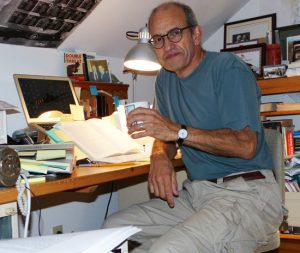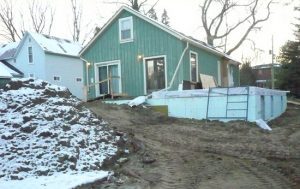
It was a few weeks after summer had officially begun. I was up in my writing roost – a.k.a. my upstairs office. With the start of summer, I had just started writing a book. I’m not being presumptuous. It’s often what I’ve done over the past 15 or 20 years – I’ve taken the summer to complete a manuscript, I hope for publication soon after the summer is done. Anyway, I heard an SUV pull up next door and a man stepped out and began assembling his survey equipment. I asked him what was going on.
“They’re going to start building here,” he said. “They’re just waiting for this survey.”
A short while later, he’d found the corner steel survey pegs, some of which I guess have been in the ground since this part of the world became a town site after 1806. At any rate, I realized things were about to change next door. My new neighbours – John and Candy – would soon be visiting more often as the site was excavated, as the footings and foundations were poured, and as their new house took shape. We’ve actually known each other a while, and they’re just as curious about my writing as I am about their building. In fact, each time they’ve stopped by this summer we’ve had the same introductory exchange.
“How’s the house coming?” I ask.
“How’s the book coming?” they ask.
It’s part of our routine now. They tell me how the foundation, the porch, and the garage are progressing. I give them a word or two from my latest chapter. It’s an odd sort of coincidence, but as I think about some of nearly 20 books I’ve written, almost every one of them was created as some sort of construction was going on around me. I recall when I was writing my first book in the early 1970s, we lived in an apartment and a friend actually created an office framework of desk surfaces, shelving, file space and hanging trusses around me as I wrote.

And when I was writing my book about the Korean War, in the late ’90s, I remember we were having our foundation rebuilt and, well, the piles of earth rising around the place made our home look like the front-line trenches of the 38th Parallel in Korea. Maybe the rumbling of a backhoe, the whining of a wood saw, the pounding of hammers on nails or the roar of a torch welding pipes together gets me moving, the same way it does a machine-operator, a framer, a roofer or a plumber.
But this has become an extraordinary summer for construction on our street. Maybe it’s a good sign for the economy. Not only do I have new neighbours building to the south of me. So too is there a new family moving in north of me. But before they take possession, they appear to have gutted the house, I guess to install the amenities to their exact liking.
Then just up the next street there’s a professional who’s had the 1960s-era house she’s acquired for her practice completely renovated. Then, across her street, the folks have done a complete makeover on their home – adding kitchen, living room, garage, etc. And each day this summer I’ve walked/driven by I’ve marvelled at the excitement, energy and innovation of it all. What writer wouldn’t be inspired by all that industry around him?
When we lived in Edmonton back in the 1980s, I teamed up with a couple of sports writers to develop a book about the then upstart pro hockey team in town and their upstart players. John Short, George Hanson and I were interviewing, researching and writing a book about Peter Pocklington, Glen Sather, Wayne Gretzky, Mark Messier, Grant Fuhr and the rest of the Edmonton Oilers. We figured they would win the Stanley Cup that spring of 1983.
At the same time, our family was renovating the kitchen. I mean we’d pulled out the sinks, the counters, the floors, everything. I remember washing dishes on my knees in the bathroom tub. And amid the dust, clutter and evolution of our kitchen reno, so our book, “Positive Power,” about the Oilers and their first serious run for the Cup took shape. We got our kitchen reno done that spring. We finished the book in time for the Oilers’ big finish, but the New York Islanders swept them four straight in the Stanley Cup final.
“This Cup is so great,” Islanders goalie Billy Smith told reporters, “because we beat Edmonton.”
What am I saying here? Maybe writing is as much a physical process as a mental one – organizing the thoughts like tools, banging together ideas like two-by-fours, sandpapering rough edges into smooth ones, polishing up concepts with images and titles. It’s no wonder some call writing a craft as much as an art. I just hope by the time my neighbours’ house is built, I can tell them that my book is built too.